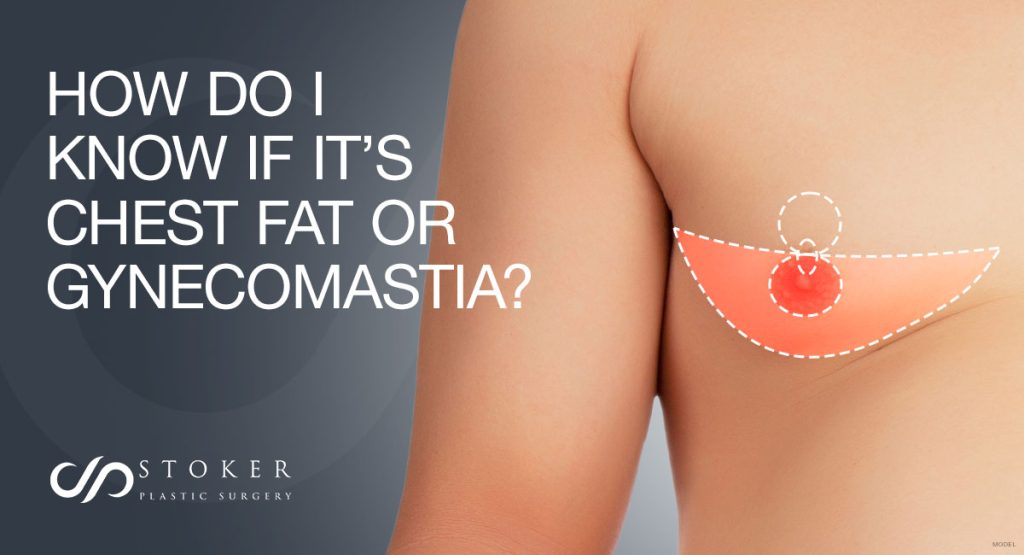Being a guy with overly developed breasts can be embarrassing, whether a teenager or an adult. It is often caused by a condition called gynecomastia, which is quite common and may go away on its own if you’re an adolescent going through puberty. Many people ask how to know if their “man boobs” are caused by chest fat or gynecomastia.
Determining whether the appearance of your breasts is caused by gynecomastia or fat—sometimes called pseudo-gynecomastia—can be tricky. Sometimes it’s a combination of gynecomastia and fat that causes the breasts to become overdeveloped. Fatty gynecomastia may respond to changes in your diet and increased exercise, but that’s not always the case.
In this post, I’ll explain the causes of gynecomastia, how to tell the difference between gynecomastia and chest fat, and describe treatment options to create a more masculine chest.
What Is Gynecomastia?
Gynecomastia is the abnormal development of tissues and glands in the male breast. The condition may develop during adolescence and then disappear over time. For various reasons, however, some men experience gynecomastia and choose male breast reduction surgery to remove the excess tissue.
Because gynecomastia involves excessive glandular tissue in the chest rather than fat, many people may develop the condition even if they’re not overweight.
What Causes Gynecomastia?
Teenagers who develop gynecomastia are typically experiencing hormonal changes that occur during puberty. This is usually temporary and goes away within 6 months to 2 years. For about 20% of people, though, gynecomastia persists beyond puberty. When gynecomastia is diagnosed in adults, the causes can vary quite a bit.
Some of the reasons men develop gynecomastia include:
- Side effects of certain medications, including antidepressants and blood pressure medication
- Changes in hormone levels for older men
- Excessive marijuana use
- Steroid use
Underlying health issues may also be responsible for increased breast tissue in men. Treating the condition usually will resolve gynecomastia.
Chest Fat vs. Gynecomastia: How To Tell the Difference
A consultation with your doctor is the best and most accurate way to determine if excess chest fat or glandular tissue is responsible for having enlarged breasts. Still, you can understand the causes by looking for a few factors.
How Does it Feel?
Fat in the chest feels like it does elsewhere, such as in the stomach and thighs. It’s typically softer than how gynecomastia feels, which is firmer and even rubbery. You may even feel a solid lump below the skin with gynecomastia. If you squeeze your breast around the areola (the dark skin surrounding the nipple), you can often feel a firm nugget of breast tissue underneath the areola.
Does Changing Your Diet and Exercising Help?
The fibrous, firm tissue that is a hallmark of gynecomastia doesn’t respond to diet and exercise. Fat cells shrink if you start or increase exercise and follow a healthier diet. One side effect of obesity, though, is the production of estrogen—which means someone could have both glandular gynecomastia and fatty tissue at the same time.
Is It Painful?
Tender breasts and mild to moderate pain in the chest area are all common gynecomastia symptoms. Your chest may feel swollen, constantly sore, and painful. This typically doesn’t occur with chest fat.
How Does Your Chest Look?
Excess chest fat often appears saggy and without definition. Glandular tissue that causes gynecomastia is generally contoured or round and appears proportional. In some cases, the nipple area protrudes farther from the chest.
What Are Your Treatment Options?
Surgical options for treating gynecomastia or chest fat include excision (cutting out glandular tissue) and liposuction. In many cases, I may combine breast reduction surgery with liposuction to create the masculine contours that patients want.
Male breast reduction surgery involves making small incisions below the nipple-areola area and removing the excess tissue. In more severe cases, such as when the patient has lost significant weight, the procedure may also include removing excess skin.
Chest liposuction can produce exceptional results for patients with pseudo-gynecomastia caused by fatty tissue. During liposuction, I make a small incision at the lower lateral crease of the breast. Then I use a thin, hollow tube called a cannula to loosen and remove excess fat. I can often also remove glandular tissue through the same incision if necessary.
Here’s an example of male breast reduction with liposuction:
Having performed thousands of male chest contouring procedures, I tailor each surgery to the patient’s specific needs.

Recovery After Gynecomastia Surgery
Most patients can resume their normal routines a few days after undergoing male breast reduction surgery or liposuction, although it takes several weeks for the area to heal completely. The procedures are often performed using a local anesthetic. Some discomfort is normal and can be managed with mild pain medication. You’ll also need to wear a compression garment around the chest for about a week to help reduce swelling and bruising.
Start With a Consultation
If you are self-conscious about the appearance of your chest, surgery may be an option. Request a consultation using the online form to meet with Dr. Stoker, who can determine your best course of action. You can also call our Marina del Rey practice at (310) 300-1779 to schedule an appointment.








Leave a Reply